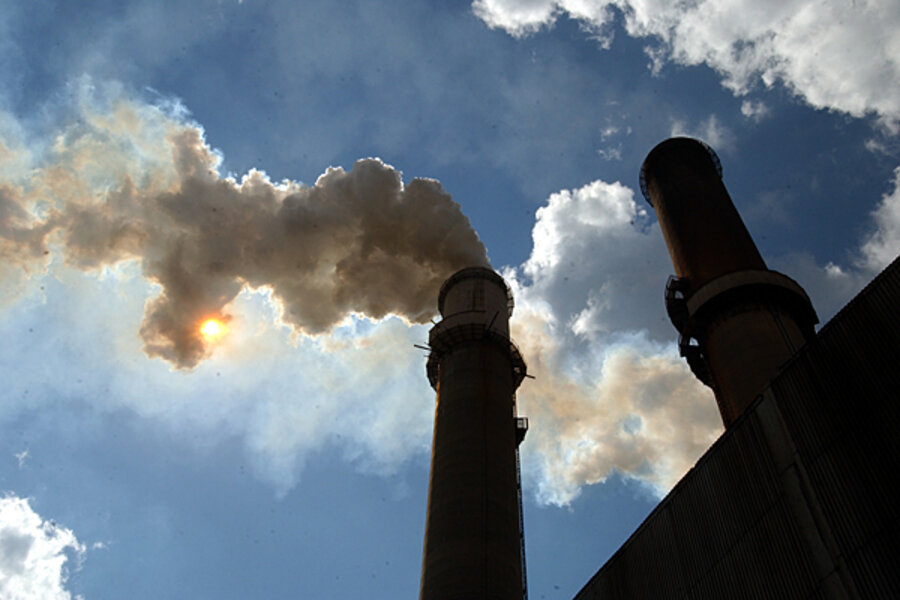EPA moves to cut power plant emissions to fight air pollution
Loading...
The Environmental Protection Agency moved Tuesday to dramatically curb power plant emissions across the central US and East Coast, a step the federal agency says will significantly reduce health and pollution impacts across that 31-state region.
Responding to a 2008 court ruling, the EPA proposed sharp cuts in emissions from some 900 coal-, natural gas-, and oil-burning power plants – a 52 percent reduction in nitrous oxide (NOX) and 71 percent cut in sulfur dioxide (SOX) by 2014.
The EPA move is intended to bring the federal government into compliance with a decision by the US Court of Appeals in Washington, D.C., that overturned the Bush administration's national Clean Air Interstate Rule (CAIR). The court found that rule failed to substantially maintain air-quality standards among states or meet statutory deadlines – and it ordered the EPA to come up with a new rule.
Tuesday's proposal – which is expected to be challenged in court – is aimed at enabling "downwind" states to develop air-pollution reduction plans based on knowing in advance how much pollution would be drifting across their borders from "upwind" states. The so-called "transport rule" would mean much tighter federal requirements for SOX and NOX emissions reductions for upwind states.
“This rule is designed to cut pollution that spreads hundreds of miles and has enormous negative impacts on millions of Americans,” EPA Administrator Lisa Jackson said in a statement. “We’re working to limit pollution at its source, rather than waiting for it to move across the country. The reductions we’re proposing will save billions in health costs, help increase American educational and economic productivity, and – most importantly – save lives.”
Curbing power plant emissions can have a large economic impact, with the cost to health and the environment from eastern power plants today exceeding $200 billion annually, according to the Environmental Defense Fund.
The EPA says its action will save an estimated $120 billion in health benefits annually by 2014, including avoiding up to 36,000 premature deaths and 1.9 million days of missed work or school due to ground-level ozone and particle pollution, the agency estimates. Such benefits would far outweigh the annual cost of compliance with the proposed rule, which the agency puts at $2.8 billion in 2014.
"This will be one of the most significant steps EPA can take to clean up the air and improve public health," Frank O’Donnell, president of Clean Air Watch, said in a statement. "This cleanup plan could literally prevent thousands of premature deaths each year and make it possible for tens of millions of others to breathe easier."
The proposal will go through a typical regulatory process with a 60-day public comment period and hearings. Agency officials expressed confidence it could sustain a legal challenge. Even after the court overturned CAIR in 2008, it reinstated it later that year to await EPA steps to correct the regulatory measure – simply because the rule had "become so intertwined with the regulatory scheme that its vacatur would sacrifice clear benefits to public health and the environment while EPA fixes the rule,” the court found.
Later this year, as the new rule kicks in, the result could include some older, dirtier power plants being closed or at least not used as much. Meanwhile, downwind states will be more confident that the air pollution reduction plans they develop will actually work, agency officials said.
"They can be confident the upwind states are equally challenged to meet air-quality requirements," Gina McCarthy, assistant EPA administrator, told reporters. "Real people will notice most of the East Coast has seen some pretty lousy ozone days. This is attempt to give people cleaner air to breathe."
The electric power sector is the nation’s single biggest source of greenhouse gases and other atmospheric contaminants like sulfur dioxide and mercury. The result is acid rain, mercury deposition, and other effects on lakes and forests.
For regional and local air pollution authorities who were anticipating a struggle to meet stringent new federal ozone pollution standards expected to be handed down next month, this new "transport rule" is a huge help.
Ohio is both downwind of Indiana, Kentucky, and Illinois – and even Texas – and upwind of Northeastern states. It is home to many power plants on the Ohio River that will have to meet tougher emissions requirements under the new rule. Its own Dayton Power and Light, for instance, will be under greater scrutiny for emissions from its smokestacks – but other emitters in other states will get tougher scrutiny, too.
"This new rule will be a big boost for us," in a bid to meet the new ozone standards that arrive next month, says John Paul, administrator of the Regional Air Pollution Control Agency of Dayton, Ohio. "This is progress."
Related:





